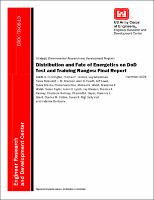Please use this identifier to cite or link to this item:
https://hdl.handle.net/11681/8521Full metadata record
| DC Field | Value | Language |
|---|---|---|
| dc.contributor | Science and Technology Corporation (Hampton, Va.) | - |
| dc.contributor | Envirostate (Firm) | - |
| dc.contributor | Computer Sciences Corporation | - |
| dc.contributor | University of New Hampshire | - |
| dc.contributor | Cold Regions Research and Engineering Laboratory (U.S.) | - |
| dc.contributor | Strategic Environmental Research and Development Program (U.S.) | - |
| dc.contributor.author | Pennington, Judith C. | - |
| dc.contributor.author | Jenkins, Thomas F. | - |
| dc.contributor.author | Ampleman, Guy, 1954- | - |
| dc.contributor.author | Thiboutot, Sonia, 1962- | - |
| dc.contributor.author | Brannon, James M. | - |
| dc.contributor.author | Hewitt, Alan D. (Alan Dole) | - |
| dc.contributor.author | Lewis, Jeff | - |
| dc.contributor.author | Brochu, Sylvie | - |
| dc.contributor.author | Diaz, Emmanuela | - |
| dc.contributor.author | Walsh, Michael R. | - |
| dc.contributor.author | Walsh, Marianne E. | - |
| dc.contributor.author | Taylor, Susan | - |
| dc.contributor.author | Lynch, Jason C. | - |
| dc.contributor.author | Clausen, Jay L. | - |
| dc.contributor.author | Ranney, Thomas A. | - |
| dc.contributor.author | Ramsey, Charles A. | - |
| dc.contributor.author | Hayes, Charolett A. | - |
| dc.contributor.author | Grant, Clarence L. | - |
| dc.contributor.author | Collins, Charles M. | - |
| dc.contributor.author | Bigl, Susan R. | - |
| dc.contributor.author | Yost, Sally L. | - |
| dc.contributor.author | Dontsova, Katerina M. | - |
| dc.date.accessioned | 2016-06-20T13:27:28Z | - |
| dc.date.available | 2016-06-20T13:27:28Z | - |
| dc.date.issued | 2006-11 | - |
| dc.identifier.uri | http://hdl.handle.net/11681/8521 | - |
| dc.description | Technical Report | - |
| dc.description | Abstract: Access to live-fire training ranges is vital in maintaining the readiness of our Armed Forces. Understanding the nature of residue deposition and fate is critical to ensuring sound management of ranges. The objective of this project was to characterize residues of high explosives on training ranges. Residues were evaluated by sampling on various types of ranges across the U.S. and Canada. Deposition from high-order and low-order detonations, demolition, including blow-in-place, was characterized. Environmental transport parameters were developed to support estimates of site-specific source terms for risk assessment and groundwater models. Protocols were developed for characterizing soils containing the highly distributed solid formulations typical of ranges. Results demonstrated that residues are specific to range activities. Demolition areas, low-order detonations sites, and firing positions have great potential for accumulation of residues. Demolition typically generates small areas of relatively high concentrations. Low-order detonations generate primarily large solid particles reflecting the predetonation composition. Artillery impact areas tend to have widely distributed, low concentrations. Firing positions may exhibit high concentrations of propellants. This project defines the characteristics, distribution, and potential environment transport of explosives residues on training ranges and provides a scientific basis for development of reasonable control measures. | - |
| dc.publisher | Environmental Laboratory (U.S.) | - |
| dc.publisher | Engineer Research and Development Center (U.S.) | - |
| dc.relation | http://acwc.sdp.sirsi.net/client/en_US/search/asset/1002736 | - |
| dc.relation.ispartofseries | ERDC TR ; 06-13. | - |
| dc.rights | Approved for public release; distribution is unlimited. | - |
| dc.source | This Digital Resource was created in Microsoft Word and Adobe Acrobat | - |
| dc.subject | Anti-tank ranges | - |
| dc.subject | Battleruns | - |
| dc.subject | Blow-in-place | - |
| dc.subject | Detonation residues | - |
| dc.subject | Explosives | - |
| dc.subject | Munitions | - |
| dc.subject | Fate and transport of explosives | - |
| dc.subject | High-order detonations | - |
| dc.subject | HMX | - |
| dc.subject | Low-order detonations | - |
| dc.subject | Propellants | - |
| dc.subject | RDX | - |
| dc.subject | Test ranges | - |
| dc.subject | Firing ranges | - |
| dc.subject | Military installations | - |
| dc.subject | TNT | - |
| dc.subject | Training ranges | - |
| dc.subject | Soil pollution | - |
| dc.subject | Groundwater | - |
| dc.subject | Environmental management | - |
| dc.title | Distribution and fate of energetics on DoD test and training ranges : final report | - |
| dc.type | Report | en_US |
| Appears in Collections: | Technical Report | |
Files in This Item:
| File | Description | Size | Format | |
|---|---|---|---|---|
| ERDC-TR-06-13.pdf | 6.41 MB | Adobe PDF |  View/Open |